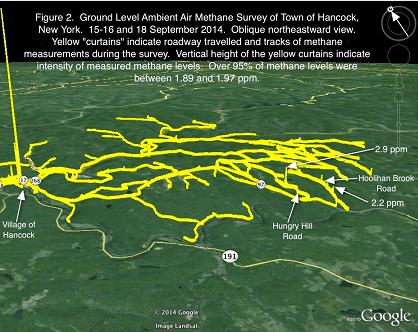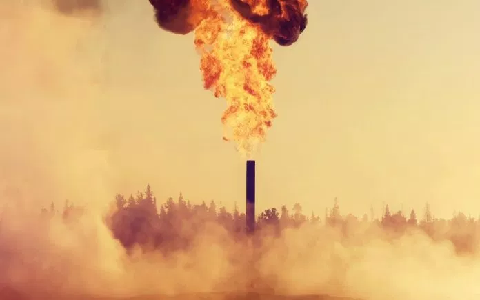Terry Greenwood Dies of Brain Cancer After Years of Fighting Fracking
December 5, 2014Radioactivity in Gas Drilling Waste
December 10, 2014Download the Hancock Methane Baseline Report as a pdf
Download the Hungry Hill Compressor Station Addenda (with before and after data)
Download this Press Release a a pdf
Natural Methane Levels in Hancock, NY
As part of an ongoing program to measure the natural base levels of methane at ground levels in our area, Damascus Citizens for Sustainability (DCS) has been carrying out a program of baseline testing in local municipalities, performed by Gas Safety, Inc, an experienced environmental testing company. In a DCS-sponsored presentation on Wednesday, December 3 at the Hancock Town Hall, Bob Ackley, president of Gas Safety; and Bryce Payne, its director of science and technology, presented the results of the recent study of the Town of Hancock.

Methane levels are of particular interest in our area because methane comprises over 95% of Marcellus shale natural gas. It is a compound that occurs naturally in air, soil and water everywhere, especially in areas like ours that overlie gas-holding shale. This kind of study establishes the natural levels of methane that occur in the municipality being measured. Should gas drilling occur – and in Hancock, about 25% of the acreage has been leased – the recent study will provide reference values that will let stakeholders from landowners to emergency responders to the gas companies themselves understand quickly whether a given methane level is natural background, or indicates a problem.
Gas Safety, Inc., uses a relatively new technology called “cavity ring-down (laser) spectrometry” (CRDS) that measures methane concentrations in parts per billion, collecting data one to five times per second. The CRDS system is mounted in a vehicle driven over public roads in the target area, producing millions of data points. Methane data points are connected to locations via GPS coordinates, which enables plotting on maps to provide a visual representation that allows for easy identification of elevated methane levels. Any such elevated levels are then cross-checked in the field against features like livestock operations, swamps or landfills that could emit methane and can explain the higher levels.
In the Town of Hancock, as in other towns for which studies have been done, Gas Safety drove along every public road with a CRDS unit to obtain its measurements. The results, like the test results for other municipalities in which drilling has not yet taken place (Damascus, PA and Sanford, NY) show relatively low and fairly consistent levels of ambient methane, 99.9% of methane levels were below 2.32 ppm with a minimum reading of 1.811 ppm. Not surprisingly, methane levels were elevated in the vicinity of the Hungry Hill compressor station, with a sharply defined elevation to 2.88 ppm on the morning of 18 September 2014. Methane levels were also elevated downtown where a gas line leak investigation and repair efforts were apparently underway.
Ackley emphasized that whether one is for or against fracking, it is common sense to perform baseline tests for ambient methane in any area where natural gas development is likely. Baseline testing should be done before gas development begins, so that any problems with elevated levels can be identified, confirmed, and the methane sources identified.
For more information and to help continue this work, visit the Donate page on www.damascuscitizens.org, call 845-252-6677 or by mail, DCS, P.O.Box 35, Narrowsburg, NY 12764 – and note that your donation is to go toward the methane baseline studies.



